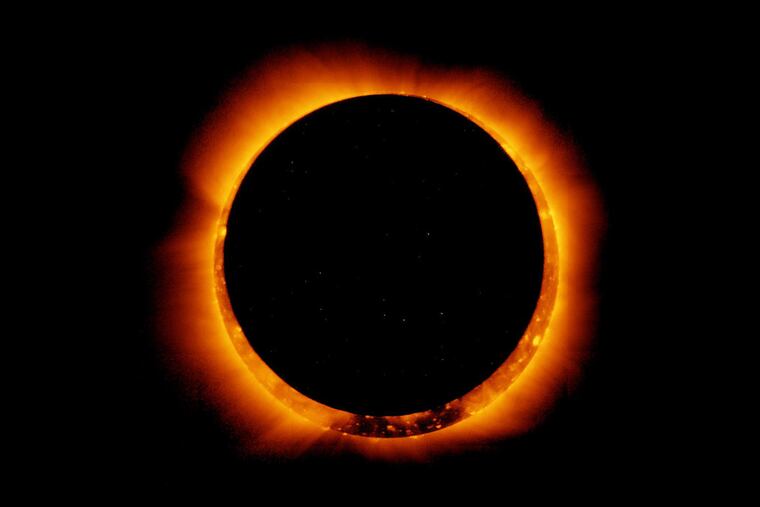Saturday’s ‘ring of fire’ eclipse will be a bonanza for scientists, even if Philly viewing conditions are poor
Somehow, the moon manages to obscure the sun, even though the sun is 400 times its size.

The “ring of fire” eclipse won’t be a visual extravaganza around Philadelphia when it occurs early Saturday afternoon, and you’ll have to settle for the livestream to see the full effects.
But this is one of the extraordinary moments in the annual celestial ballet between the sun and the moon, and is a source of great excitement in the scientific community, even rising above the baseball playoffs.
“It’s kind of like a rare experiment,” said Stan Benjamin, a researcher with the Cooperative Institute for Research in Environmental Sciences, in Boulder, Colo.
It will be an opportunity to measure how a sudden loss of solar radiation affects the atmosphere as the moon eventually blots out 90% of the sun for a few minutes in parts of the nation, leaving only an “annular” ring around the rim of our solar system’s star.
It also gives astrophysicists an opportunity to examine the enigmatic and unimaginably hot lower atmosphere of the sun, said Bennett A. Maruca, a physics and astronomy professor at the University of Delaware.
» READ MORE: 'Fly Me to the Moon:' Someday it might be more than a song
What is an ‘annular’ eclipse?
The Earth is a special place for eclipses, which occur when the moon passes between the Earth and sun. That may seem simple enough given that the moon appears to be about the same size as the sun from our perspective.
However, the sun is 400 times the size of the moon. It just so happens that the sun also on average is about 400 times farther from Earth.
“It’s quite a coincidence,” said Maruca. And it’s unique to Earth in our solar system.
During perigee, when the moon is closest to us and appears larger (think “supermoon”), it is capable of darkening the sun entirely. At apogee, when it’s farthest away, as it is now, it can knock out about 90% of the light, leaving only that spectacular ring.
» READ MORE: The moon made its closest approach to Earth in July; this time is farther away
People under clear skies will be able to see the full salami along a corridor from southeast Texas to Oregon. In Philly, about 25% of the sun will be blocked.
Eclipses occur about twice a year, said Marucca. The fact they don’t happen more often has to do with angle of the moon’s orbital path.
What will we see in the Philly region?
The sun is expected to be 100% obscured in the skies over Philly during the eclipse period, from 12:05 p.m. until about 2:30 p.m. Saturday. “That has nothing to do with the moon,” said Bob Larsen, senior meteorologist with AccuWeather Inc. The forecast calls for clouds and rain all day.
We get another chance to catch an eclipse on April 8, 2024, when about 90% of the sun will be in shadow.
What will happen during annularity?
Although not as much as during a total eclipse, the light dims.
“The birds start getting confused,” said Benjamin. “Is this an early sunset? We don’t know what’s going on.”
The Earth will cool temporarily and slightly, he said. He estimates the planet’s temperature will drop all of 0.001 degrees.
What’s in it for science?
The eclipse will be a test for NOAA’s high-resolution computer model that it uses for very short-range forecasts. It has been deployed frequently during snowstorms and was the source of those wildfire-smoke forecasts during the summer.
» READ MORE: Computer models, like meteorologists, can be fallible
The model, updated every hour, now incorporates the rapid changes in sunlight during eclipses and how that might affect the short-term availability of solar energy and the winds at the surface. It can forecast out to 48 hours. It performed successfully during an Arctic eclipse two years ago, NOAA says, and this will be its first crack at one in the continental United States.
“This is a really important thing for the power generation industry across the country,” said Benjamin.
Accurate forecasts would give wind- and solar-power companies a heads-up in planning for disruptions.
» READ MORE: What to know about installing solar panels
Delaware’s Maruca said the eclipse also would give astrophysicists a “really unprecedented view of the sun’s atmosphere.” The sun’s very brilliance makes that a year-round challenge, but with the moon in the way, they will be able to see some of the deepest portions of the atmosphere.
Silver linings
Even though the clouds are likely to spoil Saturday’s show, the eclipse “is an opportunity for us to get connected to the sun,” Maruca said, the sun being pretty much the ballgame on planet Earth. “The sun touches every part our lives,” and the eclipse is a chance “to learn more about it, and appreciate it a little more.”
Even if you don’t see it Saturday.